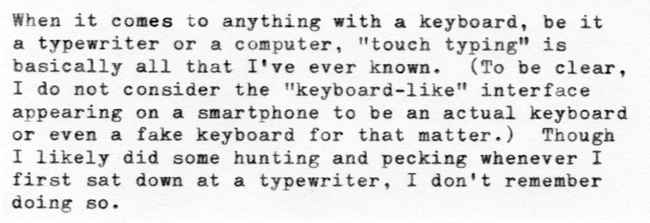
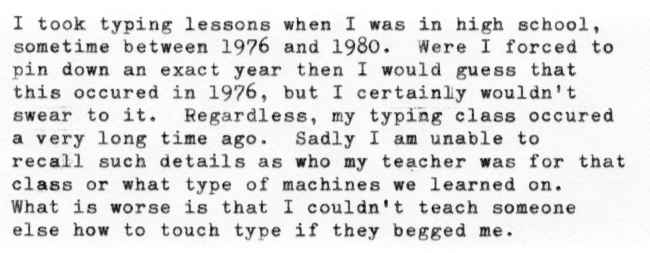
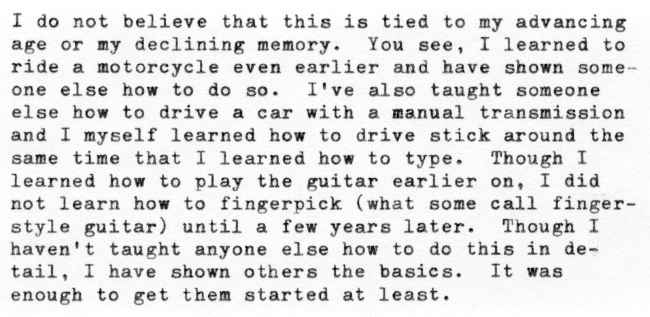
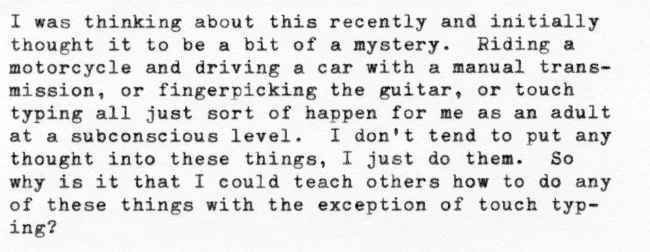
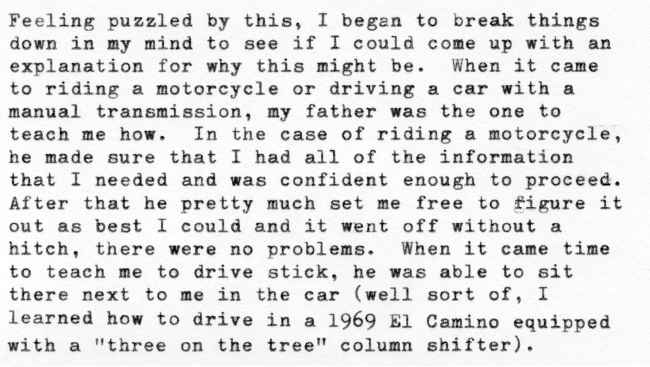
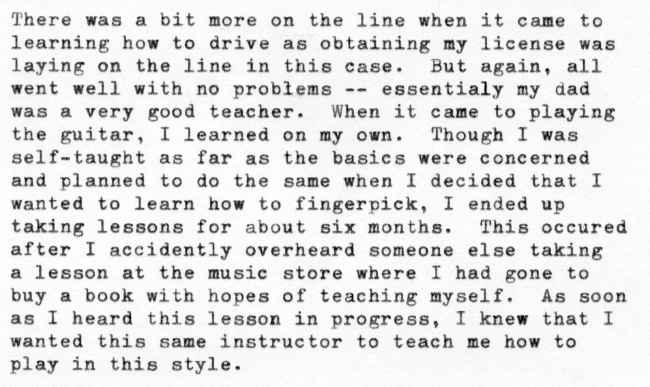
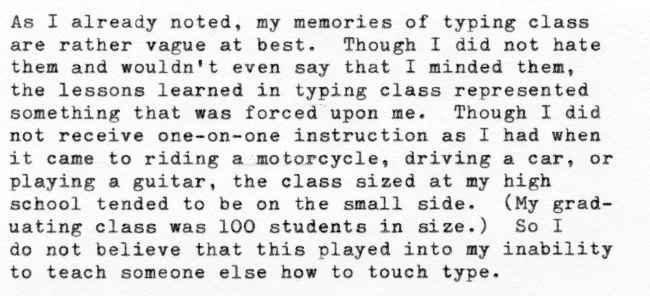
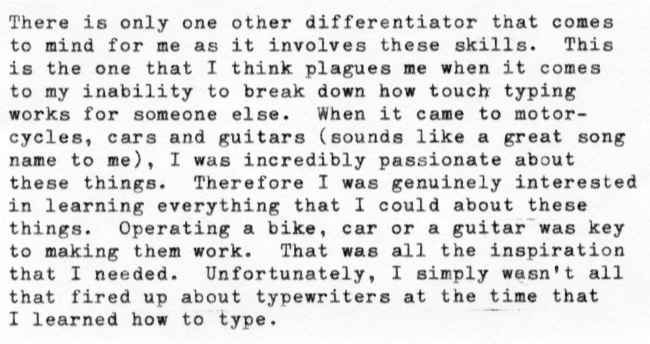

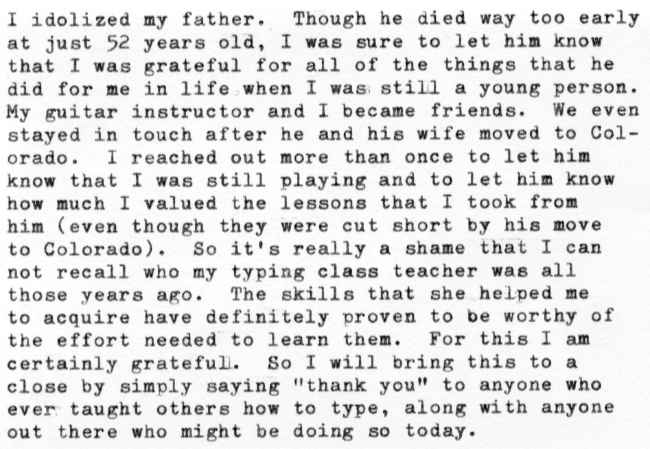
When it comes to anything with a keyboard, be it a typewriter or a computer, “touch typing” is basically all that I’ve ever known. (To be clear, I do not consider the “keyboard-like” interface appearing on a smartphone to be an actual keyboard or even a fake keyboard for that matter.) Though I likely did some hunting and pecking whenever I first sat down at a typewriter, I don’t remember doing so.
I took typing lessons when I was in high school, sometime between 1976 and 1980. Were I forced to pin down an exact year then I would guess that this occurred in 1976, but I certainly wouldn’t swear to it. Regardless, my typing class occurred a very long time ago. Sadly I am unable to recall such details as who my teacher was for that class or what type of machines we learned on. What is worse is that I couldn’t teach someone else how to touch type if they begged me.
I do not believe that this is tied to my advancing age or my declining memory. You see, I learned to ride a motorcycle even earlier and have shown some one else how to do so. I’ve also taught someone else how to drive a car with a manual transmission and I myself learned how to drive stick around the same time that I learned how to type. Though I learned how to play the guitar earlier on, I did not learn how to fingerpick (what some call fingerstyle guitar) until a few years later. Though I haven’t taught anyone else how to do this in detail, I have shown others the basics. It was enough to get them started at least.
I was thinking about this recently and initially thought it to be a bit of a mystery. Riding a motorcycle and driving a car with a manual transmission, or fingerpicking the guitar, or touch typing all just sort of happen for me as an adult at a subconscious level. I don’t tend to put any thought into these things, I just do them. So why is it that I could teach others how to do any of these things with the exception of touch typing?
Feeling puzzled by this, I began to break things down in my mind to see if I could come up with an explanation for why this might be. When it came to riding a motorcycle or driving a car with a manual transmission, my father was the one to teach me how. In the case of riding a motorcycle, he made sure that I had all of the information that I needed and was confident enough to proceed. After that he pretty much set me free to figure it out as best I could and it went off without a hitch, there were no problems. When it came time to teach me to drive stick, he was able to sit there next to me in the car (well sort of, I learned how to drive in a 1969 El Camino equipped with a “three on the tree” column shifter).
There was a bit more on the line when it came to learning how to drive as obtaining my license was laying on the line in this case. But again, all went well with no problems — essentially my dad was a very good teacher. When it came to playing the guitar, I learned on my own. Though I was self-taught as far as the basics were concerned and planned to do the same when I decided that I wanted to learn how to fingerpick, I ended up taking lessons for about six months. This occured after I accidentally overheard someone else taking a lesson at the music store where I had gone to buy a book with hopes of teaching myself. As soon as I heard this lesson in progress, I knew that I wanted this same instructor to teach me how to play in this style.
As I already noted, my memories of typing class are rather vague at best. Though I did not hate them and wouldn’t even say that I minded them, the lessons learned in typing class represented something that was forced upon me. Though I did not receive one-on-one instruction as I had when it came to riding a motorcycle, driving a car, or playing a guitar, the class sizes at my high school tended to be on the small side. (My graduating class was 100 students in size.) So I do not believe that this played into my inability to teach someone else how to touch type.
There is only one other differentiator that comes to mind for me as it involves these skills. This is the one that I think plagues me when it comes to my inability to break down how touch typing works for someone else. When it came to motorcycles, cars and guitars (sounds like a great song name to me), I was incredibly passionate about these things. Therefore I was genuinely interested in learning everything that I could about these things. Operating a bike, car or a guitar was key to making them work. That was all the inspiration that I needed. Unfortunately, I simply wasn’t all that fired up about typewriters at the time that I learned how to type.
Yet here I now sit, typing away on a piece that I am writing for my typewriter-related blog. What can I say, life is weird. It’s incredibly ironic that this skill of touch typing, one of the skills that I was least excited about learning in my life, has proven to be one of the most used skills that I possess. It has been all along ever since I learned how to do so.
I idolized my father. Though he died way too early at just 52 years old, I was sure to let him know that I was grateful for all of the things that he did for me in life when I was still a young person. My guitar instructor and I became friends. We even stayed in touch after he and his wife moved to Colorado. I reached out more than once to let him know that I was still playing and to let him know how much I valued the lessons that I took from him (even though they were cut short by his move to Colorado). So it’s really a shame that I can not recall who my typing class teacher. was all those years ago. The skills that she helped me to acquire have definitely proven to be worthy of the effort needed to learn them. For this I am certainly grateful. So I will bring this to a close by simply saying “thank you” to anyone who ever taught others how to type, along with anyone out there who might be doing so today.
AFTERTHOUGHTS: Manual transmissions are quite the rarity here in the United States these days. Unlike typewriters, I imagine that they will be a thing of the past worldwide in just a few more decades. Fingerpicking is a method of playing the guitar where the guitarist uses multiple fingers (and the thumb) on the picking hand to pluck the strings instead of using the picking hand to hold a flatpick (or plectrum). Here are some examples of my playing if you care to listen.

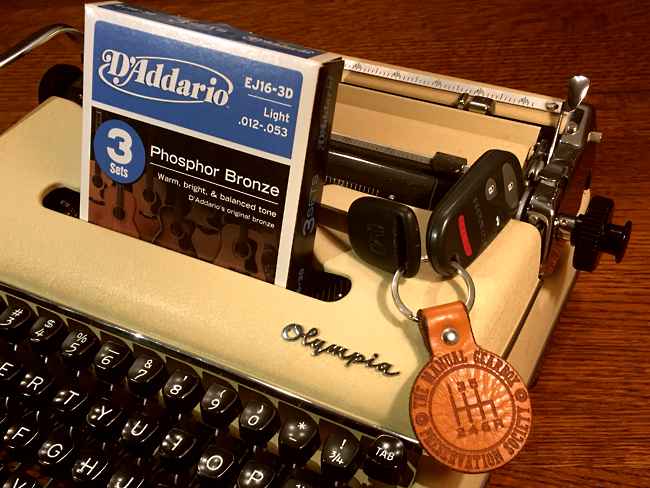
Nice memories.
I chose to take typing in high school. I was lucky to get Mrs. Smith as she was the best of the 3, Miss. Troutman, and Mrs. Adams. I can still hear Mr.s Smith every time I finish typing, “… now class be sure to remove your paper, center the carriage, and cover your typewriters.” I sometimes hear Miss Troutman across the hall calling cadence, “Now class get ready to type 2-3-4, type,2,3,4…” I’m glad I had Mrs. Smith.
I’m impressed that not only do you remember Mrs. Smith (who clearly made a positive impression on you), but also Miss. Troutman and Mrs. Adams as well.
Manual transmissions. There’s a long ago memory. In my day that was the norm. The rich kids had automatics. I learned on a three on the tree mid sixties Chevy Biscayne. A road hog for sure. My dad and Harry who owned the private (only) driving school in my town taught me enough to be rudimentary safe on the road.
Whenever I think of the Chevy Biscayne, my mind always goes straight to the classic sleeper version (equipped with the 427 big block). I bought my first car in the late 70’s.Though automatic transmissions were widely available among the used car choices of the time, I was primarily interested in those models with manual transmissions. I had a thing for British sports cars and wound up with a 1972 Triumph Spitfire which came equipped with a 4-speed (and it needed every one of them).
In 1999 I ordered a brand new Ford F150 with a small 4.6L V8 and a manual transmission with over-drive from the factory.
One day at work, I got a call from the Ford team leader on the factory floor in Kansas…calling to confirm I wanted the manual and when I told him yes, he said he and his build team were so glad to get to build it for me.
Fast forward to 2022, and I still own and drive this F150 as my daily driver (even in my retirement). Now has 200K miles on it and is still running strong and always garaged at our home.
My first car was a British Hillman with manual shifter. Stayed with British motorcars for years with my last being a Triumph TR7 in 1979 Then I moved over to several Volvo’s all with manual transmissions.
My Ford F150 will get a new engine and manual transmission rebuilt, eventually. I love how it is not filled with all sorts of electronic gadgets/
Hi Bill,
Love your story. I could talk about driving tractors and a combine harvester on the farm at a young age. My dad taught my brothers and me how to use the clutch.
You might have heard this from me before on TCL.
At 54, I decided to learn on my own how to touch-type with all fingers. In all the years before, I was only using six fingers to type and had to look at the keyboard doing so.
I searched and found a 1976 touch-typing manual. Not just any manual but the one “official” manual that was used to teach in all public schools in the province of Québec. It was important to me because the keyboard on my typewriters has keys the English language does not use: French diacritics.
I also found old manuals from the US dating to 1944 and 1948. These are great with lots of good tips as well.
Since last spring, I am doing my lessons on my own and find great satisfaction from finally being able to type without looking at the keyboard.
Teaching others might just consist of following the lessons in the manual!
Cheers!
Daniel, I love your tale of how you came to learn touch typing later on in life. I honestly view this as being very similar to someone taking up the playing of a musical instrument later on as an adult. In either case, I’m impressed. So I tip my cap to you, well done!
Your last comment is ironic. I honestly almost wrote something to the effect of the only way I could help others learn how to touch type would be to refer them to a book.
Hi Bill,
Speaking of driving manual shift cars…
When I was 14 yrs old, I bought a Renault Dauphine for $ 60 dollars and taught myself to drive with that car. I parked it 2 blocks away from my home and no one knew I had it. I drove only side roads and managed never to be spotted by our police. Bought license plates with current DMV tags at the local scrap yard.
All through the years, I only drove manual shifts. Went through some Triumphs (TR3, GT6, and 2 TR7’s) and some boxy Volvos.
In 1999, I special ordered a F-150 Flareside with a small V8 and a manual shift on the floor.
I still have this truck 22-23 years later.
My wife has a nice M-B sedan with automatic, and I am glad to mostly be her passenger.
Thanks for the comment Pete. That’s a tale of real determination — great story! It sounds like you’ve had a variety of interesting cars over the years. The fact that you’ve stuck with the F-150 for as long as you have speaks volumes. Sounds like you made a very wise buying choice, one that spoke to your preferences.
I was lucky that our school was a little poor and still had old manual typewriters in 1986. Even though I remember Mr. Langley’s class very well, I have no idea what machines we used. He was an excellent typing teacher, and I’ll never forget to, “Exercise those pinkies!” Finally reaching 40 WPM felt like winning a NASCAR race. On a computer nowadays it’s more like 60, but switching to manual typewriter slows me down to about 25. I never really thought much about the act of typing itself, until I became enamored with typewriters, and now here I am, training my fingers one again to pop the keys with equal force. You’re absolutely correct, Bill. Touch typing is one of the best skills anybody can learn.
Thanks Mei, good points. (It’s interesting just how much better 25 WPM on a manual typewriter can feel compared to 60 WPM on a computer.)
I consider typing the most useful thing I learned in high school — more than math, chemistry or biology (that’s a big deal since I’m a scientist).
I can’t remember the name of my typing teacher, but can picture her at the front of the class, her back to us so we were similarly oriented, hands up, reciting characters while moving the finger that was to strike that particular key. She required that we looked at her and not the keyboard during this exercise. After a couple of weeks, we had our first speed test. I eventually worked my way up to 82 wpm on an Olympia SM9.
Our typing classroom had electrics on one side, Olympia SM9s on the other — we were randomly assigned a spot and kept it the entire semester. The abuse those Olympias took…despite being warned not to, we all slammed the carriage return during those timed tests. I’m so much more gentle with my Olympias now (ha-ha).